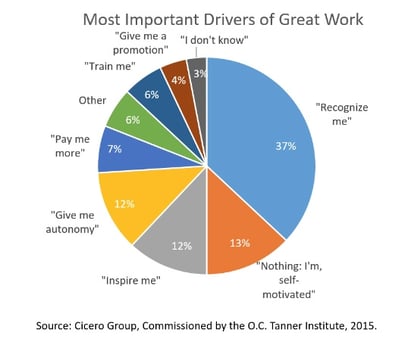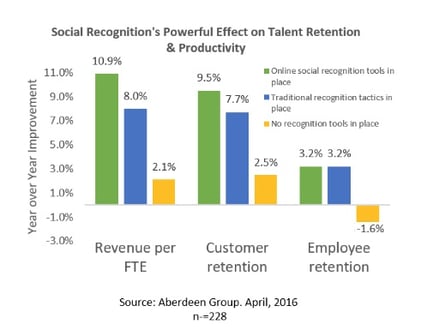
If you have social collaboration and networking platforms in your organization, you already have what you need to launch the best-performing engagement program possible. If you have a recognition and rewards platform with social tools, all the better.
Of all recognition program, social can give you the best results at the lowest cost. Let’s take a look at the impact a good program can have on your organization.
- Recognition is the most important driver of great work (O. C. Tanner).

- 91% of employees recognized reported they felt “highly motivated to contribute to the success of their organization," (O. C. Tanner).
- A commitment to valuing employees is the top factor in removing their uncertainty about company leadership. Confidence in leadership is the #1 influence in employee engagement, and commitment to valuing employees is #2 (Cicero Group).
- Social recognition is the most powerful recognition program (Aberdeen Group).
- Organizations with online social recognition tools have a 36% year-over-year improvement in revenue per FTE (Aberdeen Group).
We know rewards based on performance have a proven impact on performance and productivity, and no limit to the number of possible recognition programs. Anything that shows appreciation to another person will bolster their commitment and sense of belonging.
Formal loyalty awards such as those based on length of service have their impact, too. It affects not only the recipient but other employees who see that your organization rewards loyalty.
Formal recognition programs will help you keep and engage employees, and over time will enhance your company brand. But formal recognition programs can have “shelf life.” If they are not well-managed and rejuvenated from time to time, they can become Just another administrative exercise. If your top leadership, HR, and at least most of your managers are not strong supporters, a program can lose its effect.
In most organizations, responsibility for recognition falls on managers, and if you don’t have a strong, engaged cadre of leaders, you risk failure. So, we conclude that in rewards and recognition programs, we need to pay most of our attention to those who are at the touch point of appreciation.
Social recognition introduces a different dynamic into the mix. We learned this from several years inside an organization where, because of budgetary restraints, recognition and rewards programs were sparse and not well-funded. The HR group took that on by creating a culture of peer recognition.
There was no structured program, no charter, and no management. If you had spoken the term “social recognition” HR wouldn’t have known what you were saying. But it worked. Instead of creating a new program, they built informal and peer recognition into the supervisor training curriculum. They did not teach what to do, but how to frame appreciation so it was sincere and specific.
We say there was no management, but there was leadership. Chad, the HR Director, started every meeting with an appreciation for someone’s good work, whether they were at the meeting or not. You can believe the word got back to the subject of the praise quickly.
Chad modeled what he wanted people to do, in his own group and in executive meetings. Over time, such recognition became the norm throughout the organization. The recognition took many forms, from an email communication to someone’s boss to a piece of candy left on a chair.
Imagine what you could do with that leadership and the communication tools we have today. You can create a  culture of recognition with little more than a good example. Here are a few things we suggest to make it work better.
culture of recognition with little more than a good example. Here are a few things we suggest to make it work better.
- You may prefer to have a structured program, but take care not to make it mandatory for anyone. If you have been running recognition programs for any length of time, you know what we mean.
- Let anyone recognize anyone, and allow them to make the recognition public. If you do that, it will spread like wildfire.
- Make it easy. Don’t force people to stop what they are doing and launch a software program or create a memo. Get as much out of the way between the thought and action as you can.
- Spread the practice of personal appreciation. Have managers start their meetings by prompting their people to speak up about people who did something special.
- Create the expectation among business leaders that they should model the right behaviors and expect it of their people.
Imagine how employee Brenda will feel when she logs into her workstation in the morning and sees a message that begins with “Brenda helped us out of a jam yesterday…”
Let no good deed go unpraised.
Pixentia is a full-service technology company dedicated to helping clients solve business problems, improve the capability of their people, and achieve better results.


